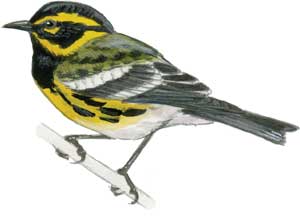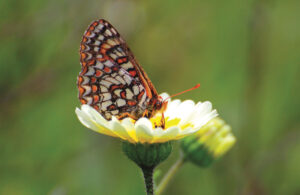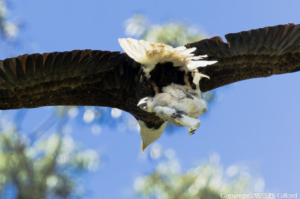Meander through an oak woodland—or even a wooded suburban area—on a winter day, and you’re likely to experience something strange about our winter woodland songbirds: You may not see them at all. In fact, the woods may seem to be utterly devoid of avian life.
Then suddenly the trees come alive with dozens of birds of several species, all chattering noisily and moving energetically from branch to branch, tree to tree, popping in and out of view. There’s the loudly scolding chestnut-backed chickadee, the drab Hutton’s vireo, and a flash of brilliant yellow as the Townsend’s warbler flits among the branches.
Chickadees may be the most common and Townsend’s the most colorful of the flock, but it’s the nonstop antics of the hyperactive ruby-crowned kinglet that will likely catch your eye. Weighing no more than a few pennies, this diminutive bird leaves its northern and Sierra Nevada mountain breeding grounds in fall and settles in for winter along the temperate California coast.
Winter is a very active time for kinglets and other small birds that don’t fly south, because they lose heat at a phenomenal rate (a kinglet without its feathers would lose heat 60 times faster than a naked human) and must eat up to three times their body weight each day to keep their metabolic furnaces burning on the coldest winter days.
That’s why tiny kinglets move like excited windup toys, bouncing from branch to branch in an incessant quest for aphids, spiders, insect eggs, and overwintering caterpillars. They cannot afford to let a single daytime hour pass without food or they begin to starve to death, and if temperatures plummet below freezing, this window of survival dips to mere minutes.
The mechanics of flight prevent birds from bulking up with extra layers of fat or feathers to survive the winter. Instead, small birds live day to day, searching out and eating enough food to fatten up and get through a single long, cold night while staying trim enough to fly away from predators.
Wintering songbirds put aside their breeding-season territorial squabbles to join mixed-species flocks focused on finding food and avoiding predators. These flocks are unique in including a mix of resident and migrant birds that hang out together for much of the winter. Since many of the birds in an area end up feeding and traveling together, the forest can feel empty until you run across one of these big, noisy groups—a mix of winter visitors like ruby-crowned kinglets and Townsend’s warblers, as well as resident chestnut-backed chickadees, white-breasted nuthatches, Bewick’s wrens, and bushtits.
- Townsend’s warbler. Illustration by Jack Laws.
Each mixed-species flock acts almost as if it were a single organism, spreading out and coalescing again like an amoeba. Those constellations of bright voices you hear in the treetops may seem fleeting and insubstantial, but as a group, the flock will often occupy and defend a home territory, follow specific flight paths and daily routines, or even reassemble each winter in roughly the same configuration.
For birds that visit us in winter, like the kinglet, these flocks provide an opportunity to hang out with birds from resident populations that are well adapted to the local landscape. Uncommon birds like the Townsend’s warbler join these groups because they aren’t numerous enough to form their own species-specific flocks. And all the birds in a mixed-species flock benefit from having many eyes watching for predators, giving each bird more time to focus on finding food instead of worrying about incoming hawks or prowling stray cats.
But cooperative flocking behavior is possible only when birds don’t have reproductive hormones coursing through their bloodstreams; as spring approaches, things begin to change. Watch ruby-crowned kinglets closely, and you’ll see clues about how and why the mixed flocks eventually dissolve.
The males’ jewel-red crests are generally hidden, but by late winter they raise their eponymous ruby crowns again and again in increasingly aggressive shows of reproductive readiness. As spring sets in, the kinglets and other migrants depart, and the cooperative, cosmopolitan winter flock dissolves in the face of another breeding season.

.jpg)




